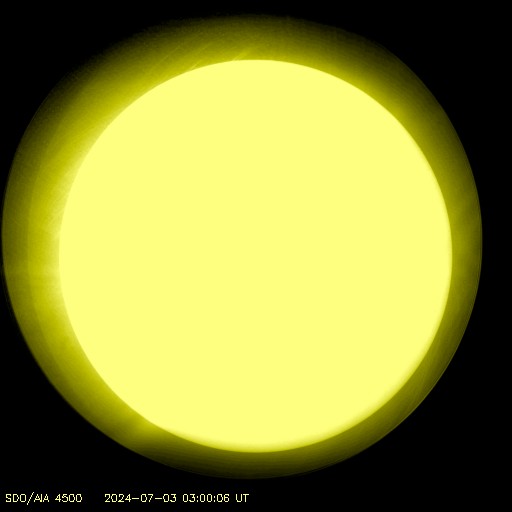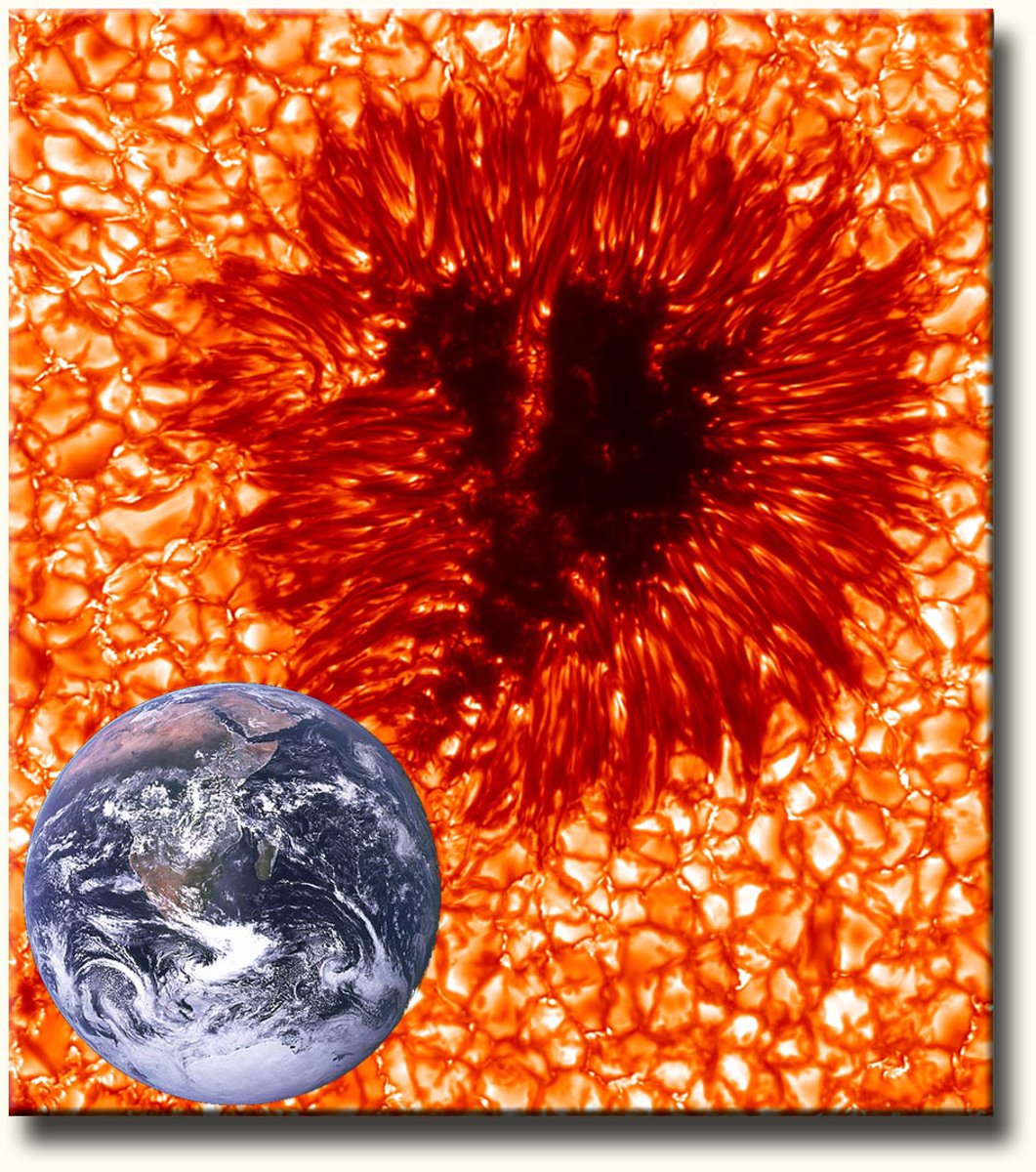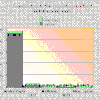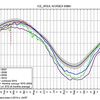Þriðjudagur, 14. júní 2011
American Astronomical Society í dag: Þrjá rannsóknir benda til hratt minnkandi sólvirkni á næstunni...
Merkilegar fréttir voru að berast í dag frá ráðstefnu Bandaríska Stjarnfræðifélagsins, American Astronomical Society, sem haldin er í þessari viku í New Mexico State University í Las Cruces, New Mexico. Lesa má frétt um málið á SPACE.COM. Sjá hér. Upphaflega fréttatilkynningin er hér neðst á síðunni og myndir sem henni fylgdu eru hér. Vídeó-frétt John Colemans má sjá hér. Samkvæmt fréttinni benda niðurstöður þriggja rannsókna til þess að virkni sólar stefni í mjög mikla lægð á næstu árum. Um er að ræða rannsóknir í iðrum sólar, á yfirborðinu og í kórónu hennar. Um sólina má fræðast hér á Stjörnufræðivefnum. Fréttin frá ráðstefnunni hefst þannig:
Þessi frétt barst í dag kl. 17 að íslenskum tíma. Væntanlega á hún eftir að vekja athygli og umræður. Sjá nánar á Space.com: Sun's Fading Spots Signal Big Drop in Solar Activity |

Sólin í dag. Sjá dagsetningu og tíma á myndinni.
(UT = Universal Time sem er sama og íslenskur staðartími).
Fjölda beintengdra mynda og ferla má sjá hér á Solar Reference Page.
Fréttin í dag hefur vakið athygli og er víða. Sjá til dæmis: Hér. Hér. Hér. Hér.
National Geographic:
Sun Headed Into Hibernation, Solar Studies Predict
Sunspots may disappear altogether in next cycle.
--- --- ---
Sjá upphaflegu fréttatilkynningurna hér:
http://www.boulder.swri.edu/~deforest/SPD-sunspot-release/SPD_solar_cycle_release.txt
** Please note the strict embargo until Tuesday, 14 June 2011, at 11 a.m.
MDT (17:00 UTC), coincident with presentation at the annual meeting of the
AAS Solar Physics Division in Las Cruces, NM. {RTF} **
EMBARGOED until:
June 14, 2011
1 p.m. EDT / 10 a.m. PDT
Contacts:
Dave Dooling
NSO Education and Public Outreach
+1 575-434-7015 (office); +1 575-921-8736 (cell)
dooling@nso.edu
Craig DeForest
AAS/SPD Press Officer
+1 303-641-5679 (cell)
deforest@boulder.swri.edu
Text & Images (after the embargo expires):
http://www.boulder.swri.edu/~deforest/SPD-sunspot-release
(Media teleconference information at bottom of this release.)
WHAT’S DOWN WITH THE SUN?
MAJOR DROP IN SOLAR ACTIVITY PREDICTED
A missing jet stream, fading spots, and slower activity near the poles say
that our Sun is heading for a rest period even as it is acting up for the
first time in years, according to scientists at the National Solar
Observatory (NSO) and the Air Force Research Laboratory (AFRL).
As the current sunspot cycle, Cycle 24, begins to ramp up toward maximum,
independent studies of the solar interior, visible surface, and the corona
indicate that the next 11-year solar sunspot cycle, Cycle 25, will be
greatly reduced or may not happen at all.
The results were announced at the annual meeting of the Solar Physics
Division of the American Astronomical Society, which is being held this week
at New Mexico State University in Las Cruces:
http://astronomy.nmsu.edu/SPD2011/
“This is highly unusual and unexpected,” Dr. Frank Hill, associate director
of the NSO’s Solar Synoptic Network, said of the results. “But the fact that
three completely different views of the Sun point in the same direction is a
powerful indicator that the sunspot cycle may be going into hibernation.”
Spot numbers and other solar activity rise and fall about every 11 years,
which is half of the Sun’s 22-year magnetic interval since the Sun’s
magnetic poles reverse with each cycle. An immediate question is whether
this slowdown presages a second Maunder Minimum, a 70-year period with
virtually no sunspots during 1645-1715.
Hill is the lead author on one of three papers on these results being
presented this week. Using data from the Global Oscillation Network Group
(GONG) of six observing stations around the world, the team translates
surface pulsations caused by sound reverberating through the Sun into models
of the internal structure. One of their discoveries is an east-west zonal
wind flow inside the Sun, called the torsional oscillation, which starts at
mid-latitudes and migrates towards the equator. The latitude of this wind
stream matches the new spot formation in each cycle, and successfully
predicted the late onset of the current Cycle 24.
“We expected to see the start of the zonal flow for Cycle 25 by now,” Hill
explained, “but we see no sign of it. This indicates that the start of Cycle
25 may be delayed to 2021 or 2022, or may not happen at all.”
In the second paper, Matt Penn and William Livingston see a long-term
weakening trend in the strength of sunspots, and predict that by Cycle 25
magnetic fields erupting on the Sun will be so weak that few if any sunspots
will be formed. Spots are formed when intense magnetic flux tubes erupt from
the interior and keep cooled gas from circulating back to the interior. For
typical sunspots this magnetism has a strength of 2,500 to 3,500 gauss
(Earth’s magnetic field is less than 1 gauss at the surface); the field must
reach at least 1,500 gauss to form a dark spot.
Using more than 13 years of sunspot data collected at the McMath-Pierce
Telescope at Kitt Peak in Arizona, Penn and Livingston observed that the
average field strength declined about 50 gauss per year during Cycle 23 and
now in Cycle 24. They also observed that spot temperatures have risen
exactly as expected for such changes in the magnetic field. If the trend
continues, the field strength will drop below the 1,500 gauss threshold and
spots will largely disappear as the magnetic field is no longer strong
enough to overcome convective forces on the solar surface.
Moving outward, Richard Altrock, manager of the Air Force’s coronal research
program at NSO’s Sunspot, NM, facilities has observed a slowing of the “rush
to the poles,” the rapid poleward march of magnetic activity observed in the
Sun’s faint corona. Altrock used four decades of observations with NSO’s
40-cm (16-inch) coronagraphic telescope at Sunspot.
“A key thing to understand is that those wonderful, delicate coronal
features are actually powerful, robust magnetic structures rooted in the
interior of the Sun,” Altrock explained. “Changes we see in the corona
reflect changes deep inside the Sun.”
Altrock used a photometer to map iron heated to 2 million degrees C (3.6
million F). Stripped of half of its electrons, it is easily concentrated by
magnetism rising from the Sun. In a well-known pattern, new solar activity
emerges first at about 70 degrees latitude at the start of a cycle, then
towards the equator as the cycle ages. At the same time, the new magnetic
fields push remnants of the older cycle as far as 85 degrees poleward.
“In cycles 21 through 23, solar maximum occurred when this rush appeared at
an average latitude of 76 degrees,” Altrock said. “Cycle 24 started out late
and slow and may not be strong enough to create a rush to the poles,
indicating we’ll see a very weak solar maximum in 2013, if at all. If the
rush to the poles fails to complete, this creates a tremendous dilemma for
the theorists, as it would mean that Cycle 23’s magnetic field will not
completely disappear from the polar regions (the rush to the poles
accomplishes this feat). No one knows what the Sun will do in that case.”
All three of these lines of research to point to the familiar sunspot cycle
shutting down for a while.
“If we are right,” Hill concluded, “this could be the last solar maximum
we’ll see for a few decades. That would affect everything from space
exploration to Earth’s climate.”
# # #
Media teleconference information: This release is the subject of a media
teleconference at the current meeting of the American Astronomical Society’s
Solar Physics Division (AAS/SPD). The telecon will be held at 11 a.m. MDT
(17:00 UTC) on Tuesday, 14 June. Bona fide journalists are invited to attend
the teleconference and should send an e-mail to the AAS/SPD press officer,
Craig DeForest, at deforest@boulder.swri.edu, with the subject heading “SPD:
SOLAR MEDIA TELECON”, before 16:00 UTC. You will receive dial-in information
before the telecon.
These results have been presented at the current meeting of the AAS/SPD.
Citations:
16.10: “Large-Scale Zonal Flows During the Solar Minimum -- Where Is Cycle
25?” by Frank Hill, R. Howe, R. Komm, J. Christensen-Dalsgaard, T.P. Larson,
J. Schou & M. J. Thompson.
17.21: “A Decade of Diminishing Sunspot Vigor” by W. C. Livingston, M. Penn
& L. Svalgard.
18.04: “Whither Goes Cycle 24? A View from the Fe XIV Corona” by R. C.
Altrock.
---
21:30
Vísindi og fræði | Breytt 16.6.2011 kl. 07:26 | Slóð | Facebook | Athugasemdir (11)
Bloggfærslur 14. júní 2011
Um bloggið
Ginnungagap
Ýmislegt
Loftslag
Teljari
Álverð
Sólin í dag:
(Smella á mynd)
.
Olíuverðið í dag:
Nýjustu færslur
- Kínverskur loftbelgur yfir Ameríku, og Amerískur belgur yfir ...
- Vísindavefurinn: Getum við seinkað klukkunni á Íslandi og fen...
- Sjálfstæðisflokkurinn með tæplega 19% meira fylgi en Samfylki...
- Bjarni Sigurðsson harmonikkusnillingur frá Geysi. Fáein orð...
- Hvers vegna valdi Apple ekki Ísland fyrir gagnaver...?
Heimsóknir
Flettingar
- Í dag (9.5.): 19
- Sl. sólarhring: 21
- Sl. viku: 105
- Frá upphafi: 766684
Annað
- Innlit í dag: 9
- Innlit sl. viku: 64
- Gestir í dag: 8
- IP-tölur í dag: 8
Uppfært á 3 mín. fresti.
Skýringar
Tenglar
Tenglar
Ýmsar vefsíður
- Efnisyfirlit pistla
- Lofthiti - Sjávarstaða - Hafís - Sólvirkni... Beintengdir ferlar
- Club du Soleil Greinar um samaspil sólar og veðurfars
- Stjörnufræðivefurinn
- Astronomy Picture of the Day
- Climate4you
- Watts Up With That?
- World Climate Report
- CO2 Science
- The Reference Frame
- Climate-Audit
- ICECAP
- The Air Went
- Science Sceptical Blog
- Roy Spencer
- Friends of Sience
- Prometheus
- Öldur aldanna. Sjaldan er ein báran stök - einnig í veðurfari? (2003) Vefsíða ÁHB
- Gróðurhúsaáhrif eða eðlilegar sveiflur í virkni sólar? (Grein í Lesbók Mbl. 20. júní 1998) Höfundur Ágúst H. Bjarnason
- Er jörðin að hitna?-Ekki er allt sem sýnist (1998) Vefsíða ÁHB
Uppskriftir
Ýmsar mataruppskriftir
Myndaalbúm
Bloggvinir
-
 majab
majab
-
 ragu
ragu
-
 amadeus
amadeus
-
 andres08
andres08
-
 apalsson
apalsson
-
 asabjorg
asabjorg
-
 askja
askja
-
 astromix
astromix
-
 baldher
baldher
-
 biggibraga
biggibraga
-
 bjarkib
bjarkib
-
 bjarnijonsson
bjarnijonsson
-
 bjarnimax
bjarnimax
-
 bjorn-geir
bjorn-geir
-
 blindur
blindur
-
 bofs
bofs
-
 brandarar
brandarar
-
 daliaa
daliaa
-
 darwin
darwin
-
 duddi9
duddi9
-
 ea
ea
-
 egillsv
egillsv
-
 einari
einari
-
 einarstrand
einarstrand
-
 elinora
elinora
-
 elvira
elvira
-
 emilhannes
emilhannes
-
 esv
esv
-
 eyjapeyji
eyjapeyji
-
 fhg
fhg
-
 finder
finder
-
 finnur
finnur
-
 fjarki
fjarki
-
 flinston
flinston
-
 frisk
frisk
-
 gattin
gattin
-
 geiragustsson
geiragustsson
-
 gillimann
gillimann
-
 gretaro
gretaro
-
 gthg
gthg
-
 gudmbjo
gudmbjo
-
 gudni-is
gudni-is
-
 gummibraga
gummibraga
-
 gun
gun
-
 gutti
gutti
-
 haddi9001
haddi9001
-
 halldorjonsson
halldorjonsson
-
 halldors
halldors
-
 hlini
hlini
-
 hof
hof
-
 hordurhalldorsson
hordurhalldorsson
-
 hreinsamviska
hreinsamviska
-
 hronnsig
hronnsig
-
 hugdettan
hugdettan
-
 icekeiko
icekeiko
-
 ingibjorgelsa
ingibjorgelsa
-
 jakobbjornsson
jakobbjornsson
-
 jakobk
jakobk
-
 johannesthor
johannesthor
-
 johnnyboy99
johnnyboy99
-
 jonaa
jonaa
-
 jonasgunnar
jonasgunnar
-
 jonmagnusson
jonmagnusson
-
 jonpallv
jonpallv
-
 jonthorolafsson
jonthorolafsson
-
 juliusvalsson
juliusvalsson
-
 karljg
karljg
-
 katrinsnaeholm
katrinsnaeholm
-
 kikka
kikka
-
 kje
kje
-
 klarak
klarak
-
 kolbrunb
kolbrunb
-
 krissiblo
krissiblo
-
 ksh
ksh
-
 kt
kt
-
 lehamzdr
lehamzdr
-
 liljabolla
liljabolla
-
 lillagud
lillagud
-
 lindalea
lindalea
-
 lucas
lucas
-
 maeglika
maeglika
-
 maggij
maggij
-
 maggiraggi
maggiraggi
-
 marinomm
marinomm
-
 martasmarta
martasmarta
-
 marzibil
marzibil
-
 mberg
mberg
-
 midborg
midborg
-
 minos
minos
-
 morgunbladid
morgunbladid
-
 mosi
mosi
-
 mullis
mullis
-
 naflaskodun
naflaskodun
-
 nimbus
nimbus
-
 nosejob
nosejob
-
 omarbjarki
omarbjarki
-
 ormurormur
ormurormur
-
 palmig
palmig
-
 perlaoghvolparnir
perlaoghvolparnir
-
 peturmikli
peturmikli
-
 photo
photo
-
 possi
possi
-
 prakkarinn
prakkarinn
-
 raggibjarna
raggibjarna
-
 rattati
rattati
-
 ravenyonaz
ravenyonaz
-
 redlion
redlion
-
 rs1600
rs1600
-
 rynir
rynir
-
 saemi7
saemi7
-
 sesseljamaria
sesseljamaria
-
 sigfus
sigfus
-
 sigurgeirorri
sigurgeirorri
-
 sjalfstaedi
sjalfstaedi
-
 sjerasigvaldi
sjerasigvaldi
-
 skari60
skari60
-
 skulablogg
skulablogg
-
 sleggjudomarinn
sleggjudomarinn
-
 stebbix
stebbix
-
 steinibriem
steinibriem
-
 steinnhaf
steinnhaf
-
 stinajohanns
stinajohanns
-
 stjornuskodun
stjornuskodun
-
 storibjor
storibjor
-
 straitjacket
straitjacket
-
 summi
summi
-
 tannibowie
tannibowie
-
 thil
thil
-
 thjodarskutan
thjodarskutan
-
 throsturg
throsturg
-
 toro
toro
-
 tryggvigunnarhansen
tryggvigunnarhansen
-
 valdimarjohannesson
valdimarjohannesson
-
 valdinn
valdinn
-
 vefritid
vefritid
-
 vey
vey
-
 vidhorf
vidhorf
-
 vig
vig
-
 visindin
visindin
-
 vulkan
vulkan
-
 kristjan9
kristjan9
-
 arkimedes
arkimedes
-
 kliddi
kliddi
-
 eliasbe
eliasbe
Eldri færslur
- Febrúar 2023
- Janúar 2019
- Maí 2018
- Júlí 2017
- Maí 2017
- Febrúar 2017
- Janúar 2017
- Nóvember 2016
- Október 2016
- September 2016
- Júlí 2016
- Apríl 2016
- Mars 2016
- Febrúar 2016
- Janúar 2016
- Desember 2015
- Nóvember 2015
- Október 2015
- Ágúst 2015
- Júní 2015
- Maí 2015
- Apríl 2015
- Mars 2015
- Febrúar 2015
- Janúar 2015
- Desember 2014
- Nóvember 2014
- Október 2014
- September 2014
- Ágúst 2014
- Júlí 2014
- Júní 2014
- Maí 2014
- Apríl 2014
- Mars 2014
- Febrúar 2014
- Janúar 2014
- Desember 2013
- Nóvember 2013
- Október 2013
- September 2013
- Ágúst 2013
- Júlí 2013
- Júní 2013
- Maí 2013
- Apríl 2013
- Mars 2013
- Febrúar 2013
- Janúar 2013
- Desember 2012
- Nóvember 2012
- September 2012
- Ágúst 2012
- Júlí 2012
- Júní 2012
- Maí 2012
- Apríl 2012
- Mars 2012
- Febrúar 2012
- Janúar 2012
- Desember 2011
- Nóvember 2011
- Október 2011
- September 2011
- Ágúst 2011
- Júlí 2011
- Júní 2011
- Apríl 2011
- Mars 2011
- Febrúar 2011
- Janúar 2011
- Desember 2010
- Nóvember 2010
- Október 2010
- September 2010
- Ágúst 2010
- Júlí 2010
- Júní 2010
- Maí 2010
- Apríl 2010
- Mars 2010
- Febrúar 2010
- Janúar 2010
- Desember 2009
- Nóvember 2009
- Október 2009
- September 2009
- Ágúst 2009
- Júlí 2009
- Júní 2009
- Maí 2009
- Apríl 2009
- Mars 2009
- Febrúar 2009
- Janúar 2009
- Desember 2008
- Nóvember 2008
- Október 2008
- September 2008
- Ágúst 2008
- Júlí 2008
- Júní 2008
- Maí 2008
- Apríl 2008
- Mars 2008
- Febrúar 2008
- Janúar 2008
- Desember 2007
- Nóvember 2007
- Október 2007
- September 2007
- Ágúst 2007
- Júlí 2007
- Júní 2007
- Apríl 2007
- Mars 2007
- Febrúar 2007
- Janúar 2007
- Desember 2006
- Nóvember 2006
- Október 2006
- September 2006
Færsluflokkar
- Bloggar
- Bækur
- Dægurmál
- Evrópumál
- Ferðalög
- Fjármál
- Fjölmiðlar
- Heilbrigðismál
- Heimspeki
- Íþróttir
- Kjaramál
- Kvikmyndir
- Lífstíll
- Ljóð
- Löggæsla
- Mannréttindi
- Matur og drykkur
- Menning og listir
- Menntun og skóli
- Samgöngur
- Sjónvarp
- Spaugilegt
- Spil og leikir
- Stjórnmál og samfélag
- Sveitarstjórnarkosningar
- Tónlist
- Trúmál
- Trúmál og siðferði
- Tölvur og tækni
- Umhverfismál
- Utanríkismál/alþjóðamál
- Vefurinn
- Viðskipti og fjármál
- Vinir og fjölskylda
- Vísindi og fræði








